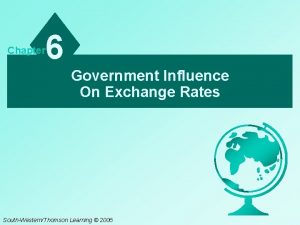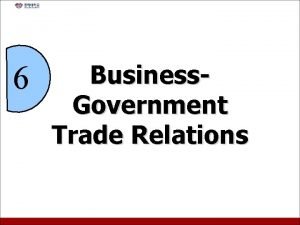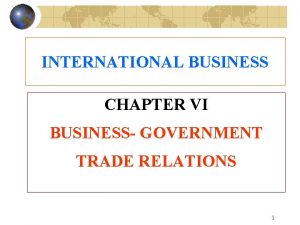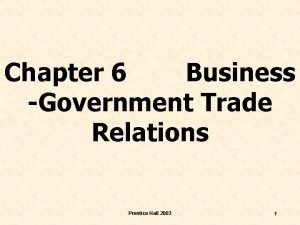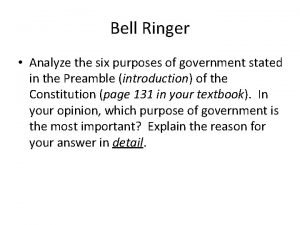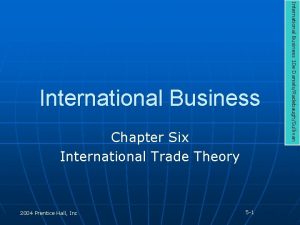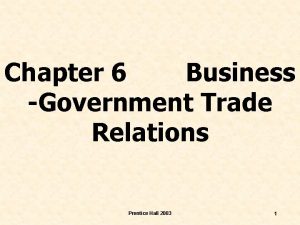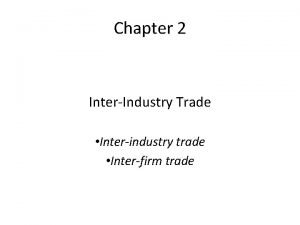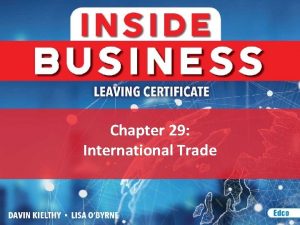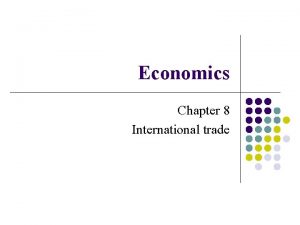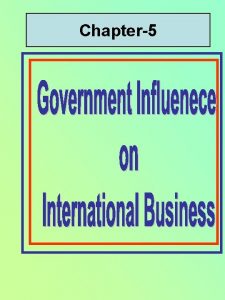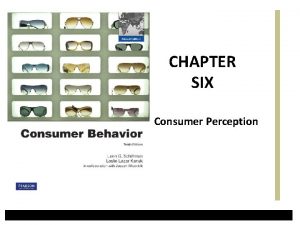Chapter Six Government Influence on Trade 2004 Prentice















- Slides: 15

Chapter Six Government Influence on Trade 2004 Prentice Hall, Inc 6 -1 International Business 10 e Daniels/Radebaugh/Sullivan International Business

Chapter Objectives n n n n Evaluate rationale for government policies that impact trade Examine effects of pressure groups Compare protectionists rationales used in developed countries with those used in emerging countries Study potential and effects of government intervention on free trade Review methods of trade restriction, regulation, and liberalization Profile the GATT and World Trade Organization Demonstrate government policies that create business uncertainty and opportunity 2004 Prentice Hall, Inc 6 -2

Effect of Government Regulations 2004 Prentice Hall, Inc Figure 6. 1 6 -3

Rationale for Government Intervention Economic Rationales Non-economic Rationale Prevent unemployment Maintain essential industries Protect infant industries Deal with unfriendly countries Promote industrialization Maintain spheres of influence Improve position compared to Preserve national identity other countries 2004 Prentice Hall, Inc 6 -4

Industrialization Argument n n n Surplus workers can more easily increase manufacturing output than agricultural output Inflows of foreign investment can promote sustainable growth Prices and sales of agricultural products and raw materials fluctuate 2004 Prentice Hall, Inc 6 -5

Industrialization Argument, con’t n n n Markets for industrial products grow faster than markets for agricultural products Local industry reduces imports and promotes exports Industrial activity helps the nation building process 2004 Prentice Hall, Inc 6 -6

Economic Relationships n n n Balance-of. Payments Adjustments Comparable access or “fairness” Price control objectives • Dumping • Optimum-tariff theory 2004 Prentice Hall, Inc 6 -7

Non-economic Rationales for Government Intervention n n Maintenance of essential industries Prevention of shipments to unfriendly countries Maintenance or extension of spheres of influence Protecting activities that preserve national identity 2004 Prentice Hall, Inc 6 -8

Government Instruments of Trade Control n Tariffs • • n n Export tariff Transit tariff Import tariff Specific duty Subsidies Aid and loans Customs valuation Quotas 2004 Prentice Hall, Inc 6 -9

Comparison of Trade Restrictions 2004 Prentice Hall, Inc Figure 6. 3 6 -10

Issues With Sanctions n n n Costs of sanctions on innocent people Inability of sanctions to induce a change in leadership Uneven application among countries Review the country’s overall record Lack of agreement about the cause being protested 2004 Prentice Hall, Inc 6 -11

General Agreement on Tariffs and Trade (GATT) n n n Formed in 1947 by 23 countries to abolish quotas and reduce tariffs Laid the foundation to liberalize world trade Required members to open markets equally to every other member However, it could not enforce compliance The World Trade Organization replaced GATT in 1995 2004 Prentice Hall, Inc 6 -12

World Trade Organization (WTO) n n n 140 current members (90% of trade) Adopted the principles and trade agreements of GATT Expanded to cover trade in • • • n n Services Investment Intellectual property Governments bring charges of unfair trade practices to the WTO rulings are binding 2004 Prentice Hall, Inc 6 -13

Dealing with Governmental Trade Influences n Companies can: • Move operations to a lower-cost country • Concentrate on markets that attract less international competition • Adopt internal innovations Increase efficiency n Superior products n • Try to get government protection 2004 Prentice Hall, Inc 6 -14

Chapter Review n n n n Evaluate rationale for government policies that impact trade Examine effects of pressure groups Compare protectionists rationales used in developed countries with those used in emerging countries Study potential and effects of government intervention on free trade Review methods of trade restriction, regulation, and liberalization Profile the GATT and World Trade Organization Demonstrate government policies that create business uncertainty and opportunity 2004 Prentice Hall, Inc 6 -15
 Government influence on exchange rates
Government influence on exchange rates Trade diversion and trade creation
Trade diversion and trade creation Umich
Umich Trade diversion and trade creation
Trade diversion and trade creation The trade in the trade-to-gdp ratio
The trade in the trade-to-gdp ratio Fair trade not free trade
Fair trade not free trade Trade diversion and trade creation
Trade diversion and trade creation Liner shipping and tramp shipping
Liner shipping and tramp shipping What is triangle trade
What is triangle trade Business government trade relations
Business government trade relations Business government trade relations
Business government trade relations Business government trade relations
Business government trade relations National government vs federal government
National government vs federal government 6 purposes of government
6 purposes of government Classify each polygon
Classify each polygon What is ode
What is ode
